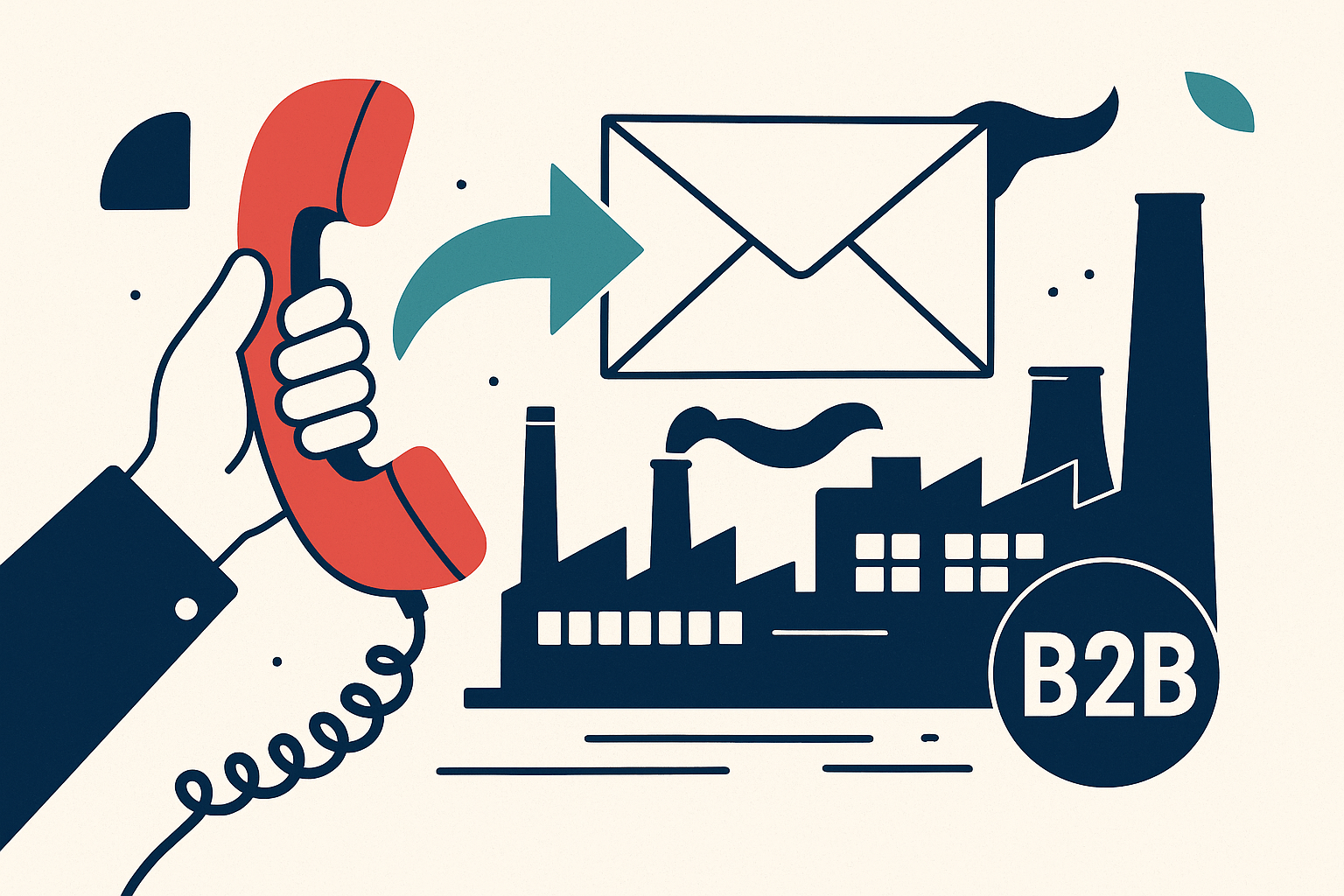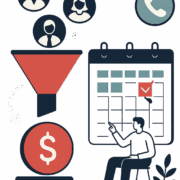Combining Cold Calling and Direct Mail for Industrial B2B
If you’re selling into industrial B2B markets, you already know your buyers aren’t easy to reach. Whether it’s a plant manager, operations director, or facilities engineer, they spend more time on the floor than online. That makes traditional digital-only tactics, like email and LinkedIn, less reliable in some manufacturing environments.
But here’s the good news: cold calling and direct mail still work—and they work even better together.
At Sapper, we’ve helped B2B manufacturers increase conversion rates, open new territories, and re-engage dormant accounts by combining the power of cold calling with targeted direct mail. This article breaks down exactly how we do it.
We’ll cover:
- Why this two-channel strategy works so well in industrial B2B
- A step-by-step process for combining cold calls and direct mail
- Real-world examples from manufacturing campaigns
- Mistakes to avoid and metrics to track
Let’s dive in.
Why Combine Cold Calling and Direct Mail?
Manufacturers operate in a different sales reality than most B2B companies. Decision-makers are hard to reach, not active on social media, and often skeptical of unknown vendors.
Here’s why cold calling + direct mail is a smart combination:
- Direct mail grabs attention. A personalized piece in the mail stands out, especially when most inboxes are overflowing.
- Cold calls create urgency. Following up a mailed piece with a phone call gives the outreach context and builds credibility.
- Physical + verbal = higher engagement. The buyer now has something in hand and someone on the phone talking about it.
Together, these two channels help cut through the noise, create familiarity, and drive real conversations.
When to Use This Strategy
This two-pronged approach works best when:
- You’re targeting high-value accounts
- You’re trying to open doors in new regions
- Digital outreach is underperforming
- You’re selling complex or capital-intensive products
- You’re looking to revive cold or inactive accounts
It’s especially effective in multi-state industrial campaigns, where personal touch and local relevance matter.
Step 1: Identify Your High-Priority Targets
Start by building a focused list of companies and contacts you want to reach. This is not a volume play—it’s about precision.
Targeting criteria for industrial B2B:
- Industries like automotive, aerospace, food processing, logistics, or metal fabrication
- Facilities with 100–2,000 employees
- Titles like Plant Manager, Director of Operations, Maintenance Supervisor, or Procurement Lead
- Geographic regions aligned to your sales reps or growth plan
Pro tip from Sapper: The best campaigns start with lists of 50–150 contacts. Keep it manageable so you can truly personalize each touchpoint.
Step 2: Create a Direct Mail Piece That Works
Forget gimmicky swag. What matters is relevance and utility. The best direct mail sends offer value in a simple, professional package.
Effective formats include:
- Folded one-page letters
- Industry-specific case studies
- Plant optimization checklists
- Brief product one-sheets tailored to the contact’s role
Design tips:
- Use company letterhead or branding
- Personalize with recipient name, company, and role
- Highlight one specific pain point and how you solve it
- Include a call to action (e.g., “Let’s talk—call me or expect a follow-up next week”)
Sapper Tip: Handwritten elements (even a simple signature or sticky note) dramatically improve response rates.
Step 3: Time the Cold Call to Follow the Mail
Once the direct mail piece is sent, timing the follow-up call is critical. You want the recipient to have the piece in hand (or at least recall seeing it) when you call.
Timing window:
- Send mail on Monday or Tuesday
- Call on Thursday or Friday of the same week
- If undelivered, call again early the next week
Script structure for the call:
“Hi [First Name], this is [Your Name] from [Company]. I sent over a short resource on reducing downtime in [industry] facilities last week—just wanted to see if it made it to your desk?”
This gives the conversation instant context. You’re not a stranger—you’re following up on something they physically received.
Step 4: Use Voicemail and Gatekeepers Wisely
In the industrial world, you won’t always get someone on the first try. That’s okay. The direct mail helps you break the barrier.
When leaving voicemails:
- Be brief and direct
- Mention the mail piece you sent
- Give a clear callback number and reason to respond
Example voicemail:
“Hi [Name], this is [Your Name] from [Company]. I sent you a short plant performance checklist last week. Just wanted to see if you had any questions or if it would make sense to connect. You can reach me at [Phone Number].”
If speaking to a gatekeeper:
- Reference the physical mail
- Ask when the best time is to reach the contact
- Be respectful—they’re your bridge, not your barrier
Step 5: Track and Measure Everything
To refine your strategy, you need to track the performance of both channels. Here’s what to monitor:
| Metric | Target Goal |
| Direct Mail Delivery Rate | 95%+ (verify addresses) |
| Cold Call Connection Rate | 15–20% |
| Voicemail Callback Rate | 5–8% |
| Appointment Conversion Rate | 10–15% |
| Meetings Booked per 100 Sends | 4–7 |
Use a CRM or outreach platform to log calls, note delivery confirmations, and follow up at the right times.
Sapper Bonus: We integrate direct mail tracking with outreach schedules so our clients know exactly when to follow up and with whom.
Case Study: Midwest Steel Supplier Using Cold Call + Direct Mail
The Client:
A regional steel supplier targeting manufacturers across Indiana, Ohio, and Michigan
The Challenge:
Break into new mid-sized manufacturing accounts where cold email had low engagement
Our Approach:
- Created a customized steel supply case study for mail
- Sent it to 75 plant managers at targeted facilities
- Followed up with phone calls within 3 days of delivery
- Used voicemails and gatekeeper strategies when needed
Results After 30 Days:
- 48 successful call connections
- 11 sales appointments booked
- 3 new customers closed within 6 weeks
- $2.1M in pipeline attributed to the campaign
Cold calling alone hadn’t worked. Direct mail alone felt like a shot in the dark. Together, they broke through.
Bonus Tactic: Include a QR Code or Landing Page
To connect offline to online, consider including a QR code or short URL on your direct mail piece.
Link it to:
- A relevant landing page
- A booking calendar
- A short video or plant walkthrough
This lets you track engagement digitally, even from physical mail, and can be a powerful data point when you follow up.
Best Practices to Maximize Effectiveness
1. Personalize at Scale
Even when sending 100+ pieces, make sure each mailer and call script references the specific contact, role, or industry.
2. Keep Messaging Tight
Don’t overexplain. One problem, one solution, one call to action.
3. Don’t Wait Too Long to Call
The longer the delay after the mail hits, the colder the call becomes.
4. Use Local Area Codes for Calls
Using a number with a local area code increases pickup rates. Tools like Aircall or PhoneBurner help automate this.
5. Follow Up More Than Once
Sometimes it takes two or three calls after a mailer to land the meeting. Persistence (without pushiness) wins.
Common Mistakes to Avoid
Mistake 1: Sending Generic Mailers
If your mail piece looks like a brochure, it’s going straight to the trash. Custom, useful, and relevant wins.
Mistake 2: Calling Without Context
Jumping into a cold call without mentioning prior outreach feels random. Use the mailer as your warm-up.
Mistake 3: Not Qualifying Before Sending
Sending direct mail to every lead in your CRM is a waste of time. Focus on high-fit, high-value accounts only.
Mistake 4: Letting Momentum Die After the First Call
If the contact says, “Call me next week,” schedule it and follow through. Treat direct mail like an investment—because it is.
Final Thoughts: Combining Tactics Creates Real Results
Industrial buyers don’t live online. They manage operations, solve plant-floor challenges, and make critical procurement decisions. Getting their attention requires a strategy rooted in real-world behavior.
By combining the personal touch of direct mail with the immediacy of a well-timed cold call, you build trust, spark curiosity, and drive engagement.
At Sapper, we manage this process end-to-end for industrial clients looking to:
- Enter new markets
- Accelerate outbound performance
- Book more qualified meetings
- Build long-term pipeline
If you’re tired of low response rates and want to start more real conversations with real buyers, this may be the system that makes the difference.
Let’s build your appointment setting engine—one phone call and one envelope at a time.










